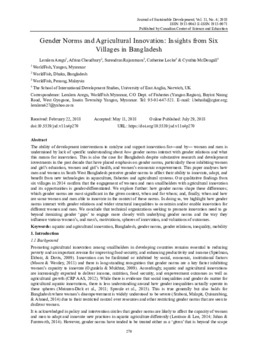Gender norms and agricultural innovation: Insights from six villages in Bangladesh
Abstract
The ability of development interventions to catalyse and support innovation for—and by— women and men is undermined by lack of specific understanding about how gender norms interact with gender relations and what this means for innovation. This is also the case for Bangladesh despite substantive research and development investments in the past decade that have placed emphasis on gender norms, particularly those inhibiting women and girl’s education, women and girl’s health, and women’s economic empowerment. This paper analyses how men and women in South West Bangladesh perceive gender norms to affect their ability to innovate, adopt, and benefit from new technologies in aquaculture, fisheries and agricultural systems. Our qualitative findings from six villages in 2014 confirm that the engagement of women and men smallholders with agricultural innovation and its opportunities is gender-differentiated. We explore further: how gender norms shape these differences; which gender norms are most significant in the given context, when and for whom; and, finally, when and how are some women and men able to innovate in the context of these norms. In doing so, we highlight how gender norms interact with gender relations and wider structural inequalities to constrain and/or enable innovation for different women and men. We conclude that technical organizations seeking to promote innovation need to go beyond itemizing gender ‘gaps’ to engage more closely with underlying gender norms and the way they influence various women’s, and men’s, motivations, spheres of innovation, and valuations of outcomes

